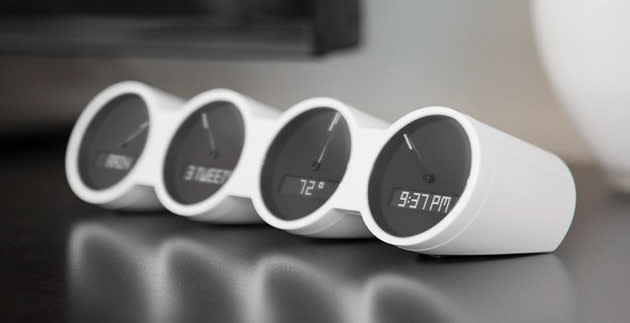Switched On: The desktop dashboard, take two

Each week Ross Rubin contributes Switched On, a column about consumer technology.
The last Switched On discussed the contrast between the $100 laptop concept of 2006 and the $100 tablet reality of 2013. In that case, an idea that didn't bear fruit was succeeded years later by a different approach. However, what's even more rare is to see a failed idea by one small company tried many years later by another small company.
This recently occurred with the introduction of the Quirky Nimbus, a physical desktop dashboard that offers four customizable displays that keep track of your digital information, like the weather, commuter traffic, email and calendar updates. The product concept is very similar to the Ambient Executive Dashboard that a yearling Switched On addressed way back in 2005 with two columns focusing on the device and its content. Contrasting that product to the Nimbus reveals that much has changed about technology in the past eight years, but there are still a few things that plague this particular niche product.
The Ambient Executive Dashboard was a device that used the pager network to obtain status updates about information that was portrayed on up to three FaceCards at a time; FaceCards were clear pieces of plastic that were inserted into the device a bit like very thin video game cartridges. A unique combination of grooves at their base told the Dashboard what information to receive. Believe it or not, since the pager network still works and is in active use, so does the Dashboard if you still have one. Turn it on and it springs to life with, for example, live information on the weather.

The Dashboard was configured on a website and many of its dozen-plus services required extra fees beyond the device's $150 price tag. However, these included some surprisingly personalized data points, some of which were more useful than those currently supported by the Nimbus, including the time until your next meeting and the number of new job listings you were monitoring.
The device was also a non-event to configure. To access personalized information, one had to register at Ambient's website, but information delivery itself was painless. As with many new hardware products, though, the Nimbus, which connects via WiFi, uses a smartphone app for configuration. There are multiple authentications required for the dubious task of monitoring how many Facebook likes your most recent post has received. However, it is early days for the Nimbus and hopefully there will be more useful apps, like the one that taps into your Fitbit step count for public bragging (or shaming).
One configures the Nimbus with the Wink app that is common to all smart devices co-developed by Quirky and GE. The app configures the device for your WiFi network by putting the iPhone's screen, for example, into a blinking mode. This too is somewhat of a throwback; a similar method was used to communicate information between PCs and early data watches from Timex. As ever, the process is error-prone and failed at least once during my setup. Still, the lack of Bluetooth helps keep down the price of the Nimbus, which costs $130.
From a design perspective, the Ambient Dashboard was one of the busiest products released by Ambient Devices, which was better known for orbs, umbrellas and other simple objects that glowed with different colors depending on status updates. Its needles represented the manifestation of the digital in the analog world. In contrast, the bulbous, toy-like Nimbus blends analog needles with a too-small LED line. This helps compensate for the inability to read the non-illuminated dials in the dark, which was an issue with the Ambient Dashboard when it was released.
The dashboard is an idea that sounds useful in theory; perhaps its best application may be as a way to hear a digital heartbeat from those we care about.
At this point, though, it seems like it would be better to replace all the faces with four small LCDs or OLED displays, which could be fully readable in low light and further customized with themes, etc. The risk, however, is making it seem too much like a digital picture frame -- another product that has fallen from grace -- or the comatose Chumby.
The Nimbus revisits the idea of glanceable information in a form factor that might replace your alarm clock. Indeed, it can be used as such and even has a snooze function. The dashboard is an idea that sounds useful in theory; perhaps its best application may be as a way to hear a digital heartbeat from those we care about. But these and similar data appliances face stronger-than-ever challenges from the constant stream of information sent to the devices in our pockets and, increasingly, on our wrists.
Ross Rubin is principal analyst at Reticle Research, a research and advisory firm focusing on consumer technology adoption. He shares commentary at Techspressive and on Twitter at @rossrubin.

